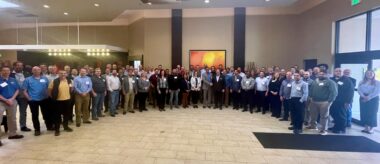At IPG, A Relentless Focus on Business Value
MLC members tour IPG's plant in Utah and learn about the company's digital transformation journey.
For Intertape Polymer Group, a manufacturer of paper- and film-based packaging products, the last six years have been a time of significant growth – and change.
Revenue during that period doubled from $750 million to $1.5 billion at the end of 2021. With 10 companies brought into the fold through acquisition, as well as through greenfield plant expansion, IPG more than doubled its worldwide factory footprint. The company, with dual headquarters in Montreal, Canada, and Sarasota, Florida, now has operations in 34 locations, including 22 manufacturing facilities in North America, and approximately 4,000 employees.
But one of the most significant changes along the way, and one that will most certainly shape its future, is a digital transformation that began in 2018 that is now being rolled out in 10 of the facilities.
To see how IPG’s digital journey has played out in one of those facilities, approximately 70 members of the Manufacturing Leadership Council toured IPG’s Tremonton, Utah plant in April. Built in 1997, the plant makes shrink films such as StretchFLEX. MLC members saw how IPG uses data from plant floor equipment such as extruders to more rapidly identify and remediate problems; how it more effectively manages parts with an automated storage system called VIDIR; how it uses so-called “hackathons” and a digital-first mindset to problem-solve; and how it uses 3D printing to speed parts making.
In a briefing before the tour, Jai Sundararaman, IPG’s Vice President of Business Transformation, described why and how IPG undertook its digital transformation journey.
He said IPG was facing a set of issues as it contemplated its digital strategy – gains from lean manufacturing were plateauing, the workforce was ageing and retirements were underway, and the potential of new technologies was looming but not yet embraced. Moreover, digital was seen as a way to “homogenize” the company’s operating culture, an important requirement as a result of the acquisitions.
To prepare for the development of its digital transformation strategy, IPG undertook a series of explorations and activities, including studying 20 different technologies, attending more than 10 industry conferences, holding multiple technology summit with vendors, and engaging in more than 25 networking sessions with fellow MLC members, Sundararaman said.
The company then adopted a phased approach to digital transformation anchored on delivering business value.
Phase one of the digital transformation was designed to reinvent operational excellence for the digital era by, in particular, using its foundational Intertape Performance System (IPS) to closely align strategy and execution and “homogenize” the company’s operating culture.
“We have cracked the code in delivering bottom line results,” said Sundararaman, who is also a member of the MLC’s Board of Governors. “And we have uncovered three to five years of opportunities for driving sustained competitive advantage with operational excellence leveraging digital technologies and processes.
“So it was about raising the game to a higher level. I would characterize it as a ‘breaking the four-minute barrier’ moment. It was truly a watershed moment when the Tremonton team broke the yield numbers and sustained it for several months. Now, the records are starting to tumble down for other lines.”
Phase one also includes systematically up-skilling and retaining talent with digital and process knowledge. Phase two will be about driving revenue and margin growth by applying digital technologies at scale in other functions such as customer engagement, he said. And Phase three, which is probably a year away, will be about business model invention leveraging digital technologies.
One of the most significant changes had to do with how IPG thought about the process of problem-solving. Before its digital transformation, as it was explained during one of the tour stops, problem-solving was undertaken using a traditional sequence – hypothesis, questions, data, and answers.
The digital sequence, though, is different. It begins with big data, followed by exploration, correlations, and, finally, insights.
During an hour-long panel discussion following the tour, IPG plant officials answered questions from MLC members concerning data standards and analysis, measuring the return from M4.0, and how to get buy-in from employees and leadership teams for M4.0 initiatives, among others.
The panelists were also asked about the future possibility of achieving so-called light’s out status in a plant and the role of artificial intelligence in operations and continuous improvement.
“We have different camps with our own groups,” one panelist said. “However, we are very surprised at the tangible results we’ve seen in the initial stages of writing these algorithms and what’s possible with AI and how self-correction could become much more common.”
